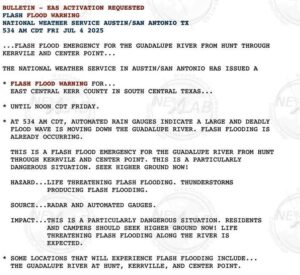
Texas continues to recover from epic flash flooding from the remnants of Tropical Storm Barry; sadly, the death toll from the flash flooding that struck the area around San Antonio and Austin has climbed to at least 82. Flooding rains continue to fall over portions of Texas, triggering flood alerts in areas still reeling from the holiday weekend disaster. President Trump has signed off on a Federal Disaster Declaration, rushing federal resources to assist with local authorities dealing with the disaster.
With dozens still missing across the state, Texas Governor Greg Abbott warns that flash flooding could still pose a danger for some regions over the next few days as “more heavy rainfall” is expected. Heavy rainfall could lead to flash flooding in the Big Country, Concho Valley, Central Texas and again in the City of Kerrville, where a majority of the destruction has been reported, Abbott said during a news conference today.
The National Weather Service office for Austin and San Antonio warns that 2-4″ of rain is expected with isolated amounts up to 10″ possible. This is in addition to all of the rain that fell in recent days associated with the remnants of Tropical Storm Barry. Tropical Storm Barry struck the Mexican coast near the Bay of Campeche on June 29. Moisture associated with the tropical storm moved north into northeastern Mexico and northeast into central Texas and hasn’t moved much since.
“This rain will aggravate ongoing flooding and likely create new flooding as soils are saturated making runoff more rapid. The heaviest rain is expected over the Hill Country to along the I-35 corridor,” warns the National Weather Service. Showers and thunderstorms may be less focused and have only slight chances on Monday.
Unfortunately, this area isn’t a stranger to severe flash flooding or excess moisture from decaying tropical cyclones. According to the National Weather Service, there have been 20 systems since 1913 that have dropped more than 20″ of rain over central Texas, with Barry becoming the latest.
In 1987, flood waters ravaged the same area hit hardest this weekend, sweeping away and drowning young people who fell victim to the Guadalupe River too.
The area that saw epic floods in Texas has seen them before. And much of Texas has dealt with flooding rains in the wake of tropical cyclones, even those that initially made landfall in Mexico. https://t.co/IdMitQ813m
— the Weatherboy (@theWeatherboy) July 6, 2025
President Donald Trump declared the region a Major Federal Disaster Area, allowing for federal resources to assist with local officials in Texas. In a letter to Texas Governor Abbott, President Trump wrote, “I have declared a major disaster under the Robert T. Stafford Disaster Relief and Emergency Assistance Act, 42 U.S.C. 5121 et seq. (the “Stafford Act”), for the State of Texas due to damage resulting from severe storms, straight-line winds, and flooding beginning on July 2, 2025, and continuing. I have authorized Federal relief and recovery assistance in the affected area. Individual Assistance and Public Assistance will be provided.”

President Trump added, “The Department of Homeland Security, Federal Emergency Management Agency (FEMA), will coordinate Federal assistance efforts and designate specific areas eligible for such assistance. The Federal Coordinating Officer will be Mr. Benjamin Abbott of FEMA. He will consult with you and assist in the execution of the FEMA-State Agreement for disaster assistance governing the expenditure of Federal funds.”
President Trump told reporters in New Jersey today that he hopes to visit Texas on Friday and said he’d go sooner, but didn’t want to get in the way of first responders still engaged in an active search/rescue mission.
State and federal officials are also dealing with a flood of misinformation around the floods, with some saying the National Weather Service lacked staff or funding and the ability to forecast the floods while others said FEMA was dismantled and unable to assist. Both are categorically false.

The National Weather Service office in Austin / San Antonio had extra staff on-hand to deal with the storm system. According to a meteorologist with the National Weather Service who spoke to the Associated Press, where the office would typically have two forecasters on duty during clear weather, they had up to five on staff. The meteorologist explained that it’s typical of National Weather Service offices to staff up for an event and bring people in on overtime and hold people over for such an event.
While the National Hurricane Center and the National Weather Service’s Weather Prediction Center warned for days of the threat lingering moisture from Tropical Storm Barry would have for the U.S., the local National Weather Service office issued a region-specific Flash Flood Watch 12 hours before the flooding occurred… and issued a Flash Flood Warning 3 hours before the primary event. They also issued a Particularly Dangerous Situation warning and triggered cell phone alerts and emergency alerts on radio and television stations warning of what was to come.